Study on the Fracture Toughness of Softwood and Hardwood Estimated by Boundary Effect Model
Abstract
:1. Introduction
2. Materials and Methods
3. Results and Discussion
3.1. Microstructures
3.2. Mechanical Properties
4. Conclusions
Supplementary Materials
Author Contributions
Funding
Institutional Review Board Statement
Informed Consent Statement
Data Availability Statement
Conflicts of Interest
References
- Chen, C.; Kuang, Y.; Zhu, S.; Burgert, I.; Keplinger, T.; Gong, A.; Li, T.; Berglund, L.; Eichhorn, S.J.; Hu, L. Structure–property–function relationships of natural and engineered wood. Nat. Rev. Mater. 2020, 5, 642–666. [Google Scholar] [CrossRef]
- Wimmers, G. Wood: A construction material for tall buildings. Nat. Rev. Mater. 2017, 2, 17051. [Google Scholar] [CrossRef]
- Balat, M.; Bozbas, K. Wood as an energy source: Potential trends, usage of wood, and energy politics. Energy Sources A 2006, 28, 837–844. [Google Scholar] [CrossRef]
- Zhong, Z.W.; Hiziroglu, S.; Chan, C.T.M. Measurement of the surface roughness of wood based materials used in furniture manufacture. Measurement 2013, 46, 1482–1487. [Google Scholar] [CrossRef]
- Chen, B.; Leiste, U.H.; Fourney, W.L.; Liu, Y.; Chen, Q.; Li, T. Hardened wood as a renewable alternative to steel and plastic. Matter 2021, 4, 3941–3952. [Google Scholar] [CrossRef]
- Goodrich, T.; Nawaz, N.; Feih, S.; Lattimer, B.Y.; Mouritz, A.P. High-temperature mechanical properties and thermal recovery of balsa wood. J. Wood Sci. 2010, 56, 437–443. [Google Scholar] [CrossRef]
- Gibson, L.J. The hierarchical structure and mechanics of plant materials. J. R. Soc. Interface 2012, 9, 2749–2766. [Google Scholar] [CrossRef]
- Dufresne, A. Nanocellulose: A new ageless bionanomaterial. Mater. Today 2013, 16, 220–227. [Google Scholar] [CrossRef]
- Ray, U.; Pang, Z.; Li, T. Mechanics of cellulose nanopaper using a scalable coarse-grained modeling scheme. Cellulose 2021, 28, 3359–3372. [Google Scholar] [CrossRef]
- Wang, X.; Xia, Q.; Jing, S.; Li, C.; Chen, Q.; Chen, B.; Pang, Z.; Jiang, B.; Gan, W.; Chen, G.; et al. Strong, Hydrostable, and Degradable Straws Based on Cellulose-Lignin Reinforced Composites. Small 2021, 17, 2008011. [Google Scholar] [CrossRef]
- Ray, U.; Zhu, S.; Pang, Z.; Li, T. Mechanics Design in Cellulose-Enabled High-Performance Functional Materials. Adv. Mater. 2021, 33, 2002504. [Google Scholar] [CrossRef]
- Keunecke, D.; Hering, S.; Niemz, P. Three-dimensional elastic behaviour of common yew and Norway spruce. Wood Sci. Technol. 2008, 42, 633–647. [Google Scholar] [CrossRef] [Green Version]
- Qing, H.; Mishnaevsky, L. 3D hierarchical computational model of wood as a cellular material with fibril reinforced, heterogeneous multiple layers. Mech. Mater. 2009, 41, 1034–1049. [Google Scholar] [CrossRef]
- Hofstetter, K.; Hellmich, C.; Eberhardsteiner, J. Development and experimental validation of a continuum micromechanics model for the elasticity of wood. Eur. J. Mech. A 2005, 24, 1030–1053. [Google Scholar] [CrossRef]
- Livani, M.A.; Bosco, E.; Suiker, A.S.J. Influence of morphology on the effective hygro-elastic properties of softwood (spruce) and hardwood (balsa). Arch. Appl. Mech. 2021, 91, 4141–4162. [Google Scholar] [CrossRef]
- Borrega, M.; Ahvenainen, P.; Serimaa, R.; Gibson, L. Composition and structure of balsa (Ochroma pyramidale) wood. Wood Sci. Technol. 2015, 49, 403–420. [Google Scholar] [CrossRef]
- Da Silva, A.; Kyriakides, S. Compressive response and failure of balsa wood. Int. J. Solids Struct. 2007, 44, 8685–8717. [Google Scholar] [CrossRef] [Green Version]
- Kanbayashi, T.; Miyafuji, H. Microscopic characterization of tension wood cell walls of Japanese beech (Fagus crenata) treated with ionic liquids. Micron 2016, 88, 24–29. [Google Scholar] [CrossRef] [PubMed]
- Koddenberg, T.; Zauner, M.; Militz, H. Three-dimensional exploration of soft-rot decayed conifer and angiosperm wood by X-ray micro-computed tomography. Micron 2020, 134, 102875. [Google Scholar] [CrossRef]
- Wang, Y.; Hu, X.; Liang, L.; Zhu, W. Determination of tensile strength and fracture toughness of concrete using notched 3-p-b specimens. Eng. Fract. Mech. 2016, 160, 67–77. [Google Scholar] [CrossRef]
- Zhang, C.; Hu, X.; Wu, Z.; Li, Q. Influence of grain size on granite strength and toughness with reliability specified by normal distribution. Theor. Appl. Fract. Mech. 2018, 96, 534–544. [Google Scholar] [CrossRef]
- Hu, X.Z.; Duan, K. Size effect and quasi-brittle fracture: The role of FPZ. Int. J. Fract. 2008, 154, 3–14. [Google Scholar] [CrossRef]
- Guan, J.; Yuan, P.; Hu, X.; Qing, L.; Yao, X. Statistical analysis of concrete fracture using normal distribution pertinent to maximum aggregate size. Theor. Appl. Fract. Mech. 2019, 101, 236–253. [Google Scholar] [CrossRef]
- Liu, W.; Yu, Y.; Hu, X.; Han, X.; Xie, P. Quasi-brittle fracture criterion of bamboo-based fiber composites in transverse direction based on boundary effect model. Compos. Struct. 2019, 220, 347–354. [Google Scholar] [CrossRef]
- Tada, H.; Paris, P.C.; Irwin, G.R. The Stress Analysis of Cracks Handbook; ASME Press: New York, NY, USA, 1973. [Google Scholar]
- Wang, B.H.; Hu, X.Z.; Lu, P.M. Modelling and testing of large-scale masonry elements under three-point bending—Tough and strong nacre-like structure enlarged by a factor of 20,000. Eng. Fract. Mech. 2020, 229, 106961. [Google Scholar] [CrossRef]
- Ji, H.; Yang, W.; Chen, D.; Li, X. Natural arrangement of fiber-like aragonites and its impact on mechanical behavior of mollusk shells: A review. J. Mech. Behav. Biomed. Mater. 2020, 110, 103940. [Google Scholar] [CrossRef] [PubMed]
- Ji, H.M.; Li, X.W.; Chen, D.L. Crack initiation and growth in a special quasi-sandwich crossed-lamellar structure in Cymbiola nobilis seashell. J. Mech. Behav. Biomed. Mater. 2019, 90, 104–112. [Google Scholar] [CrossRef]
- Li, X.; Ji, H.; Yang, W.; Zhang, G.; Chen, D. Mechanical properties of crossed-lamellar structures in biological shells: A review. J. Mech. Behav. Biomed. Mater. 2017, 74, 54–71. [Google Scholar] [CrossRef] [PubMed]
- Ji, H.M.; Li, X.W.; Chen, D.L. Cymbiola nobilis shell: Toughening mechanisms in a crossed-lamellar structure. Sci. Rep. 2017, 7, 40043. [Google Scholar] [CrossRef] [PubMed] [Green Version]
- Senalik, C.A.; Farber, B. Chapter 5: Mechanical properties of wood. In Wood Handbook—Wood as an Engineering Material; Forest Products Laboratory: Madison, WI, USA, 2021. [Google Scholar]
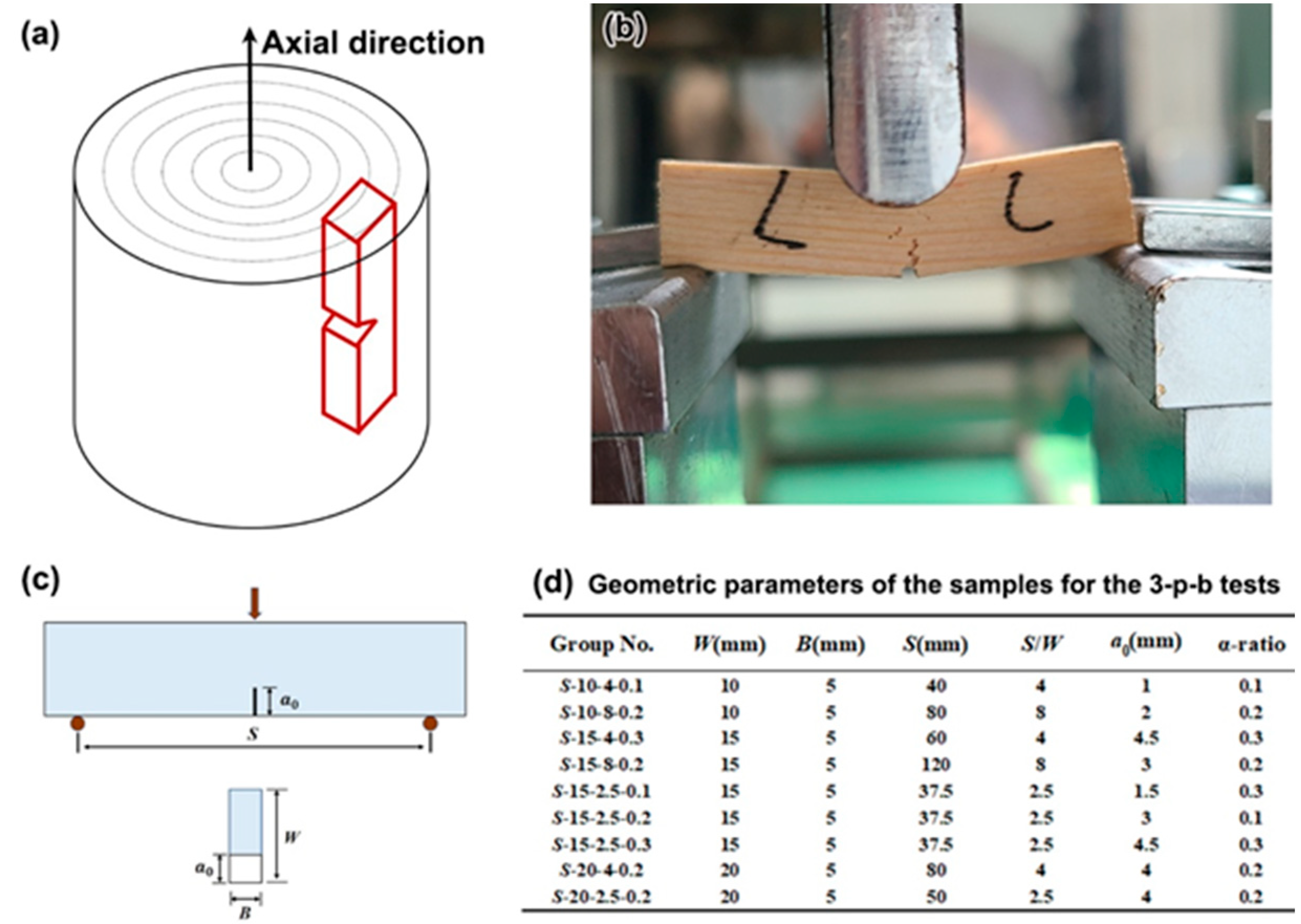
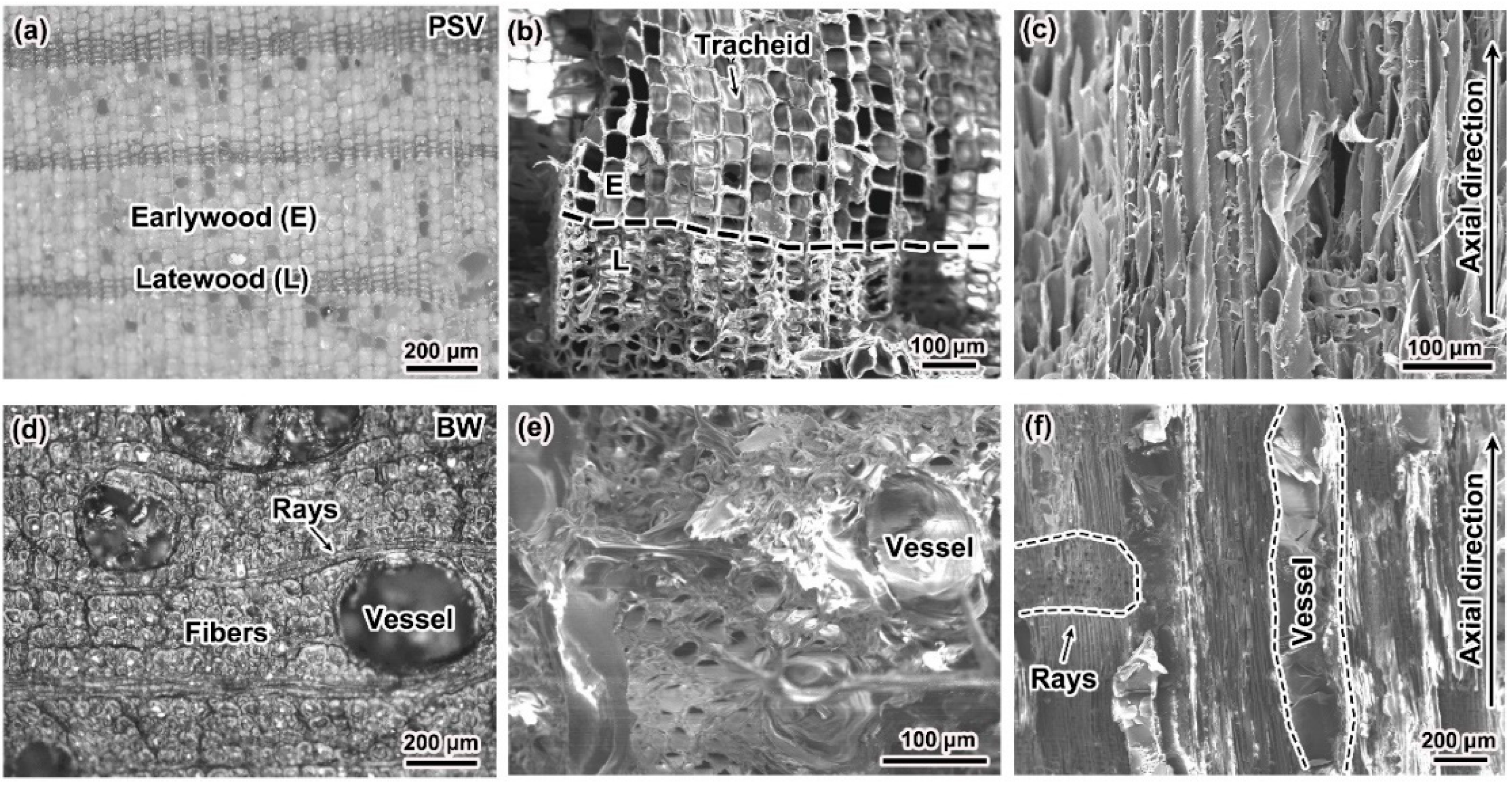
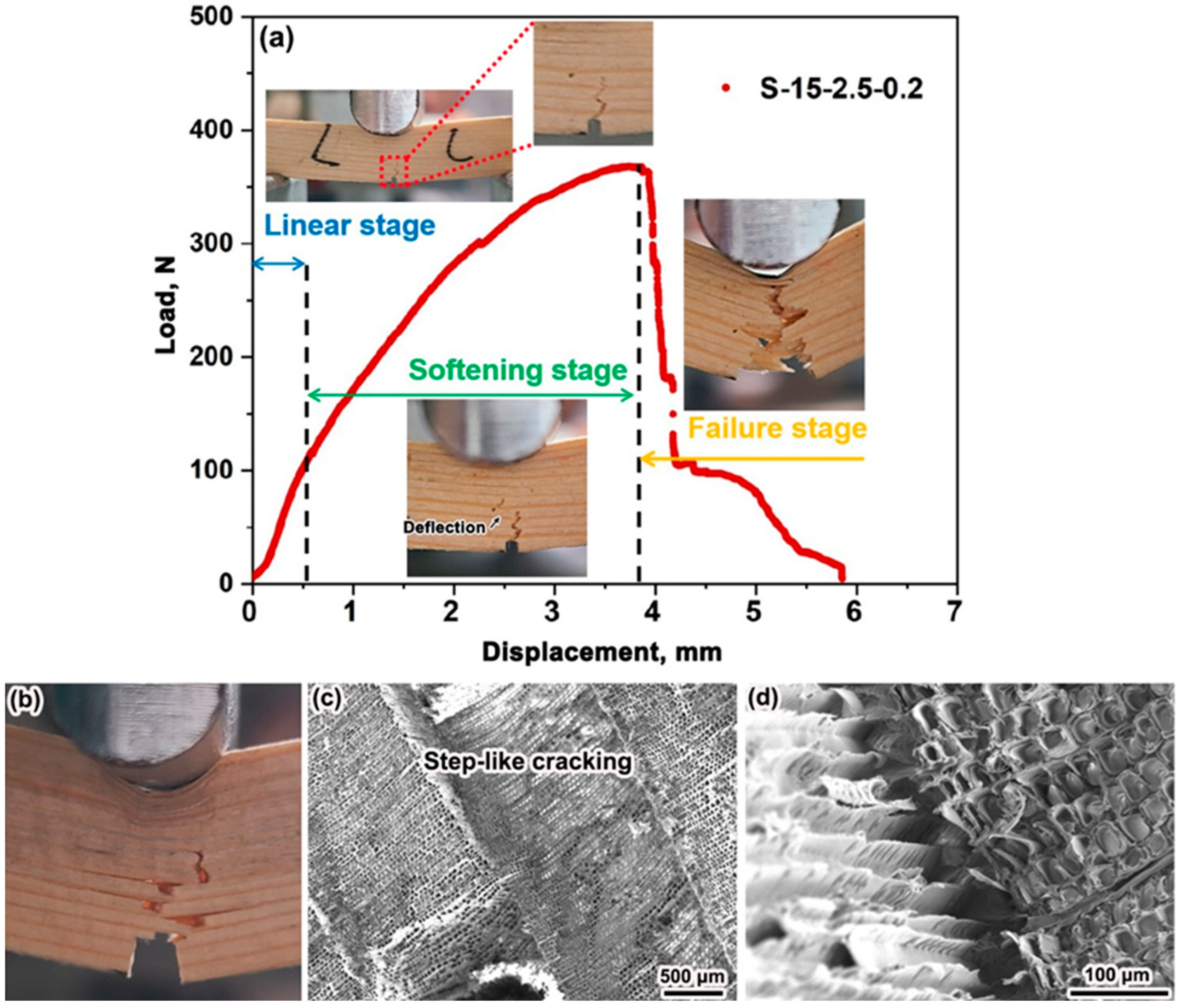

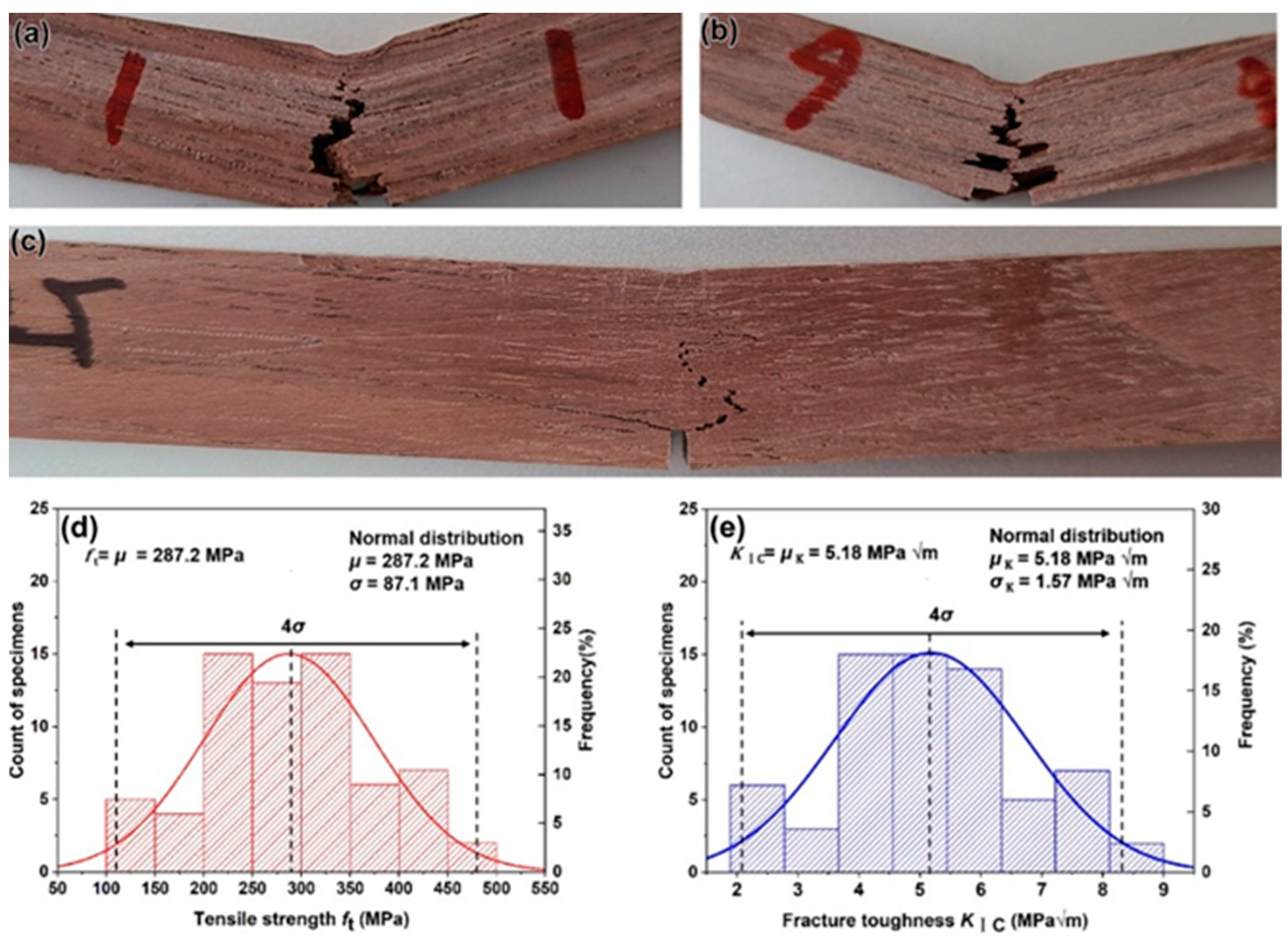
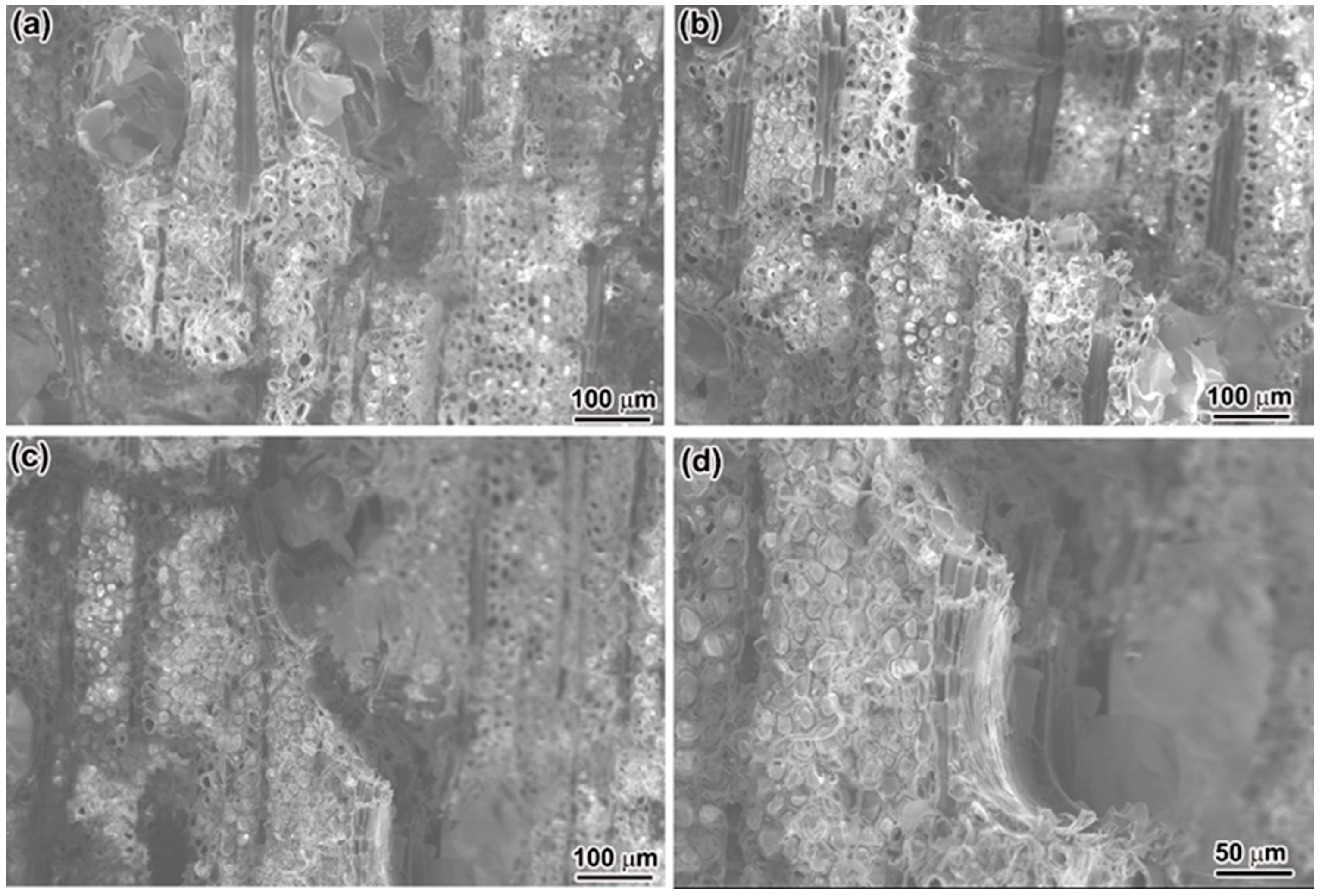
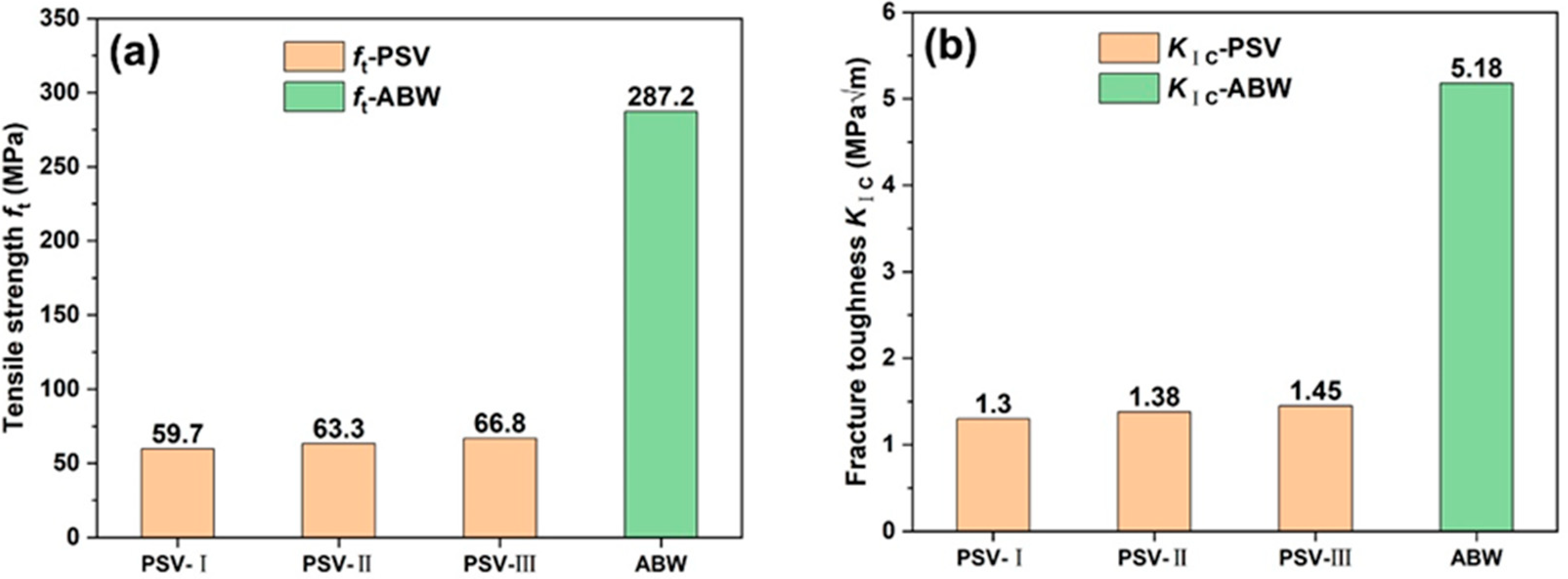
Publisher’s Note: MDPI stays neutral with regard to jurisdictional claims in published maps and institutional affiliations. |
© 2022 by the authors. Licensee MDPI, Basel, Switzerland. This article is an open access article distributed under the terms and conditions of the Creative Commons Attribution (CC BY) license (https://creativecommons.org/licenses/by/4.0/).
Share and Cite
Ji, H.-M.; Liu, X.-N.; Li, X.-W. Study on the Fracture Toughness of Softwood and Hardwood Estimated by Boundary Effect Model. Materials 2022, 15, 4039. https://doi.org/10.3390/ma15114039
Ji H-M, Liu X-N, Li X-W. Study on the Fracture Toughness of Softwood and Hardwood Estimated by Boundary Effect Model. Materials. 2022; 15(11):4039. https://doi.org/10.3390/ma15114039
Chicago/Turabian StyleJi, Hong-Mei, Xiao-Na Liu, and Xiao-Wu Li. 2022. "Study on the Fracture Toughness of Softwood and Hardwood Estimated by Boundary Effect Model" Materials 15, no. 11: 4039. https://doi.org/10.3390/ma15114039
APA StyleJi, H.-M., Liu, X.-N., & Li, X.-W. (2022). Study on the Fracture Toughness of Softwood and Hardwood Estimated by Boundary Effect Model. Materials, 15(11), 4039. https://doi.org/10.3390/ma15114039






